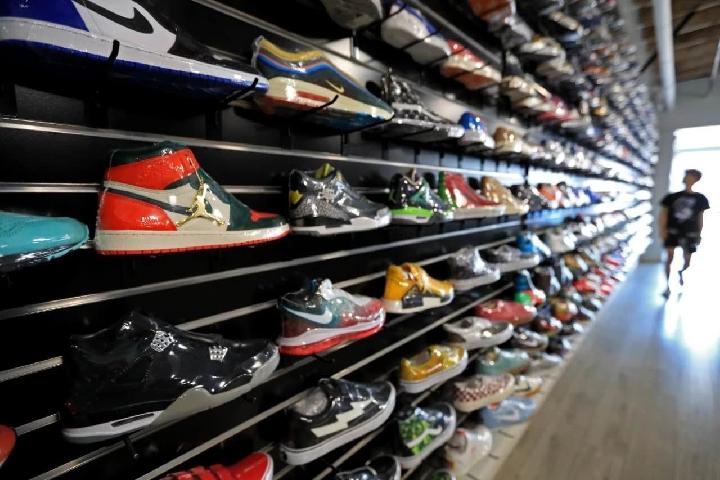TIANJIN, July 6 (Xinhua) -- Donning his wireless earbuds and his new sneakers, Chen is in high-spirits as he begins his workout routine after work in Beijing.
As a sneaker aficionado and collector, Chen, 29, used to prefer foreign brands, but now his closet is full of shoes made and designed in China.
"I have changed my opinion on Chinese sneakers in recent years. Many domestic brands are doing a good job on things like sole materials and waterproofing, as well as the design," said Chen, adding that many sneakers designed in China are now good value for money.
Running shoes made in China are outperforming the competition in the domestic market, according to statistics released in March 2021 by Joyrun, one of China's leading sports-data platforms. The figures show that, during the first quarter of this year, domestic brands occupied the top two spots in the popularity rankings for new sneakers at Tmall, an online marketplace of Chinese e-commerce giant Alibaba Group.
The same phenomenon can be seen at a branch of Li-Ning, a renowned Chinese sportswear brand, located in north China's Tianjin Municipality, where sales personnel are kept busy by customers eager to try on the sneakers.
"Domestic brands were often favored by the senior citizens due to their relatively low cost. But nowadays, the sneakers designed in China are catching on among a growing number of young customers," said Zhang Haiyuan, a shop assistant who has worked in the store for five years.
Ordinary consumers are not the only ones who have changed their minds.
At the 2019 BMW Berlin Marathon, Chinese marathon runner Dong Jianguo finished the race in two hours, 8 minutes and 28 seconds wearing sneakers made in China. At the 2020 Guangzhou Marathon and the 2020 Shanghai International Marathon, many top-ranked contestants also chose sneakers from domestic brands.
"In the past, most athletes wore shoes from famous foreign brands to help themselves get better results. But now, the performance of domestic brands has improved, making them an option for professional athletes," said Cheng Yang, creative director of Joyrun.
The domestic brands are helping athletes to improve their performance, which is a great affirmation for any sports brand, Cheng added.
The secret to success for China's best-selling sports sneakers is the combination of creativity and technological innovation.
In an operations center of Chinese sportswear producer Xtep in the city of Xiamen, in east China's Fujian Province, professional athletes run around a circular track, with HD-infrared cameras capturing their movements, while sensors record the pressure distribution and force transmission of their feet.
The company wants to make its own sneaker database with the help of high-tech equipment, including 3D foot scanners and testing machines.
"Our annual report shows that our company's investment in research and development keeps increasing every year. We are looking for potential improvements by means of scientific tests and simulation," said Zhu Ding, vice president of the Xtep brand.
Another Chinese sportswear giant called Anta has collected more than 30,000 foot types from across the country and made a specialized database for Chinese customers in search of more comfortable sneakers.
In 2019, Anta invested around 789 million yuan (about 122 million U.S. dollars) in research and development, and plans to invest more than 1 billion yuan in technological innovation over the next five years.
To win the hearts of picky Chinese customers, China's sports brands have also worked hard to improve the design and cultural connotations of their products. Traditional Chinese culture provides some rich inspiration for shoe designers.
Last year, Anta launched some new running shoes paying tribute to Li Bai, a Chinese poet from the Tang Dynasty (618-907) and a household name in modern China.
Li Bai pursued freedom throughout his life and elevated traditional Chinese poetry to a new high. Anta combined Li's philosophy of life with modern design features, rolling out some new sneakers that were a real hit among domestic consumers.
Meanwhile, Xtep hosted a fashion show last year at the Shaolin Temple in central China's Henan Province, a location strongly associated with the history of kung fu. This coincided with the incorporation of Zen culture and the spirit of Chinese kung fu into their product design, and the resulting sneakers proved very popular once they hit the market.
"As the economy develops and the urban green spaces and footpaths are perfected, young urbanites are increasingly willing to devote more time to sports," said Zhu. "They are expressing their individuality, while also being aware of Chinese brands and culture."
According to Li Dongming, secretary-general of the Tianjin Sports Industry Association, China's sports industry is growing rapidly, with emerging techniques, materials and technologies constantly being developed and applied. With more people becoming more health-conscious and taking part in daily sporting activity, Chinese sports brands will continue to enjoy great opportunities for development, said Li. Enditem




 A single purchase
A single purchase









